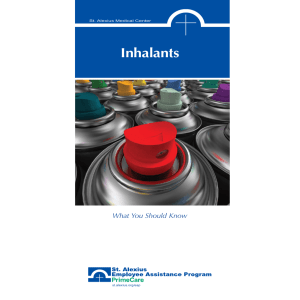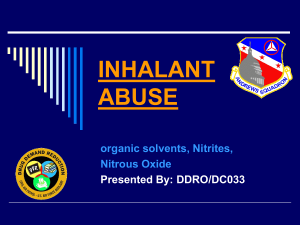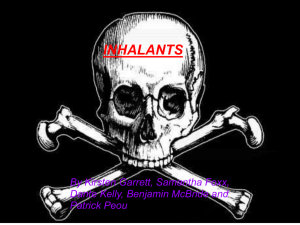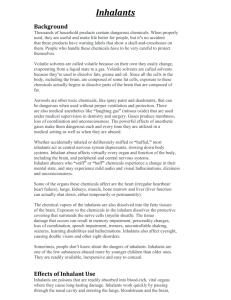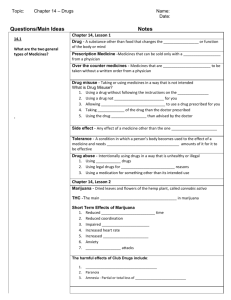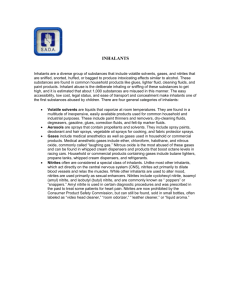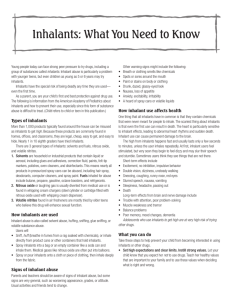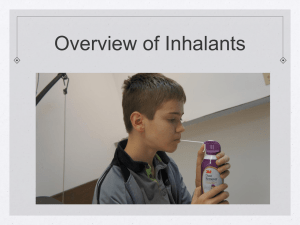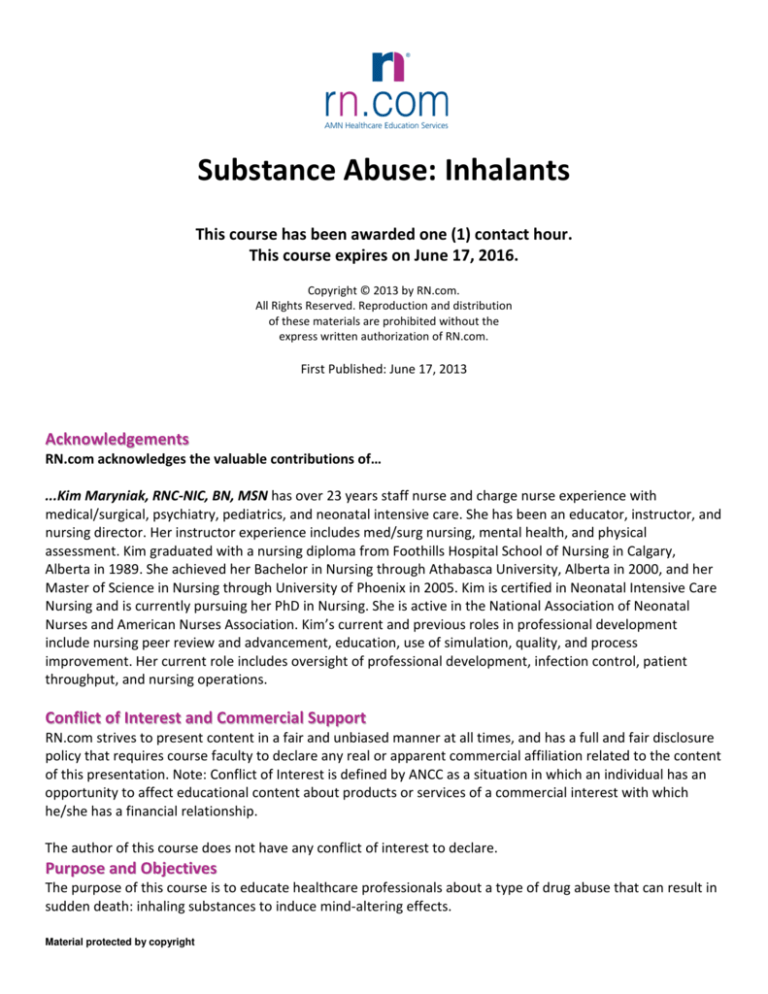
Substance Abuse: Inhalants
This course has been awarded one (1) contact hour.
This course expires on June 17, 2016.
Copyright © 2013 by RN.com.
All Rights Reserved. Reproduction and distribution
of these materials are prohibited without the
express written authorization of RN.com.
First Published: June 17, 2013
Acknowledgements
RN.com acknowledges the valuable contributions of…
...Kim Maryniak, RNC-NIC, BN, MSN has over 23 years staff nurse and charge nurse experience with
medical/surgical, psychiatry, pediatrics, and neonatal intensive care. She has been an educator, instructor, and
nursing director. Her instructor experience includes med/surg nursing, mental health, and physical
assessment. Kim graduated with a nursing diploma from Foothills Hospital School of Nursing in Calgary,
Alberta in 1989. She achieved her Bachelor in Nursing through Athabasca University, Alberta in 2000, and her
Master of Science in Nursing through University of Phoenix in 2005. Kim is certified in Neonatal Intensive Care
Nursing and is currently pursuing her PhD in Nursing. She is active in the National Association of Neonatal
Nurses and American Nurses Association. Kim’s current and previous roles in professional development
include nursing peer review and advancement, education, use of simulation, quality, and process
improvement. Her current role includes oversight of professional development, infection control, patient
throughput, and nursing operations.
Conflict of Interest and Commercial Support
RN.com strives to present content in a fair and unbiased manner at all times, and has a full and fair disclosure
policy that requires course faculty to declare any real or apparent commercial affiliation related to the content
of this presentation. Note: Conflict of Interest is defined by ANCC as a situation in which an individual has an
opportunity to affect educational content about products or services of a commercial interest with which
he/she has a financial relationship.
The author of this course does not have any conflict of interest to declare.
Purpose and Objectives
The purpose of this course is to educate healthcare professionals about a type of drug abuse that can result in
sudden death: inhaling substances to induce mind-altering effects.
Material protected by copyright
After successful completion of this course, the participant will be able to:
1. Identify types of inhalants and associated mind-altering effects
2. Identify signs and symptoms associated with inhalant abuse
3. Describe physiological effects of inhalants
4. Identify clinical management of illicit drug use
5. Describe substance abuse prevention strategies
Introduction
A plethora of solvents, gases, aerosol propellants, nitrates and other substances can be inhaled by individuals
seeking a psychoactive experience.
These substances are volatile, can emit chemical vapors, and can be inhaled to produce a variety of
pharmacological effects. Unfortunately, some of these effects may result in death.
According to NIDA (National Institute on Drug Abuse), the term inhalants encompasses a wide range of
chemicals found in hundreds of different products (NIDA, 2012a).
Because many healthcare professionals may be unfamiliar with the effects or the use of inhalants, it is
beneficial to learn about the types of products that might be inhaled, the signs and symptoms of inhalant
intoxication and the treatment for this type of abuse.
Street Names
Street names for inhalants will vary according to region and demographic.
These may include:
• Aroma of men
• Bolt
• Boppers
• Bullet
• Bullet bolt
• Buzz bomb
•
•
•
•
•
•
Discorama
Hardware
Laughing gas
Moon gas
Oz
Pearls
•
•
•
•
•
•
Poor man’s pot
Poppers
Quicksilver
Rush Snappers
Satan’s secret
Shoot the breeze
• Snappers
• Snotballs
• Whippets
(NIDA, 2011)
How Inhalants are Used
Inhalants are taken into the body using a few different methods.
They can be inhaled through the nose or mouth by:
•
•
•
•
•
Inhaling from a balloon.
“Huffing” (inhaling) from an inhalant soaked cloth stuffed into the mouth.
Snorting or sniffing fumes directly from a container.
Spraying directly into the mouth or nose.
Inhaling fumes that have been put into or sprayed into a paper or plastic bag (bagging).
Solvents may be inhaled by stuffing a solvent soaked rag into the mouth and breathing rapidly ("huffing"),
by placing a solvent soaked rag into a bag and inhaling repeatedly ("bagging") or by directly inhaling the
fumes from the container (NIDA, 2012b).
Chemicals that are inhaled become absorbed rapidly into the bloodstream. Within seconds the user
experiences effects similar to those produced by alcohol.
Material protected by copyright
The user might also experience euphoria, hallucinations, delusions, dizziness, slurred speech, lightheadedness,
or the inability to coordinate movements.
Individuals may inhale these chemicals repeatedly for hours since the effects from the inhalants don’t last
more than a few minutes (NIDA, 2012a).
With repeated inhalant use and each successive inhalation, users subject themselves to an increasing risk for a
loss of consciousness and death.
With heavy use of inhalants, abusers may become very sleepy for several hours and complain of a lingering
headache (NIDA, 2012b).
Test Yourself
Chemicals that are inhaled become absorbed rapidly into the bloodstream.
Categories of Inhalants
There are hundreds if not thousands of chemical inhalants that an individual might use to experience a mind
altering event (to get high).
NIDA (2012a) organizes inhalants into four categories based on the form in which they are found in industrial,
household and medical products.
The categories include:
•
•
•
•
Gases such as propane, butane, aerosol propellants and nitrous oxide
Volatile solvents such as glues, paint thinners and gasoline
Nitrites such ascyclohexyl, isoamyl and isobutyl
Aerosols
Common household products such as hairspray, nail polish remover and cleaning products can become
deadly when inhaled.
Types of Inhalants: Gases and Volatile Substances
Gases
Commercial and household products that contain gases that can be inhaled include whipped cream dispensers
(readily available for purchase on the internet), refrigerants, propane tanks and butane lighters.
Nitrous oxide is generally the most abused of these gases and is found in whipped cream dispensers and
products that are sold to increase octane levels in racing cars.
Medical anesthetic gases include nitrous oxide, halothane, ether and chloroform (NIDA, 2012a).
Volatile solvents
Liquids that vaporize at room temperatures are classified as volatile solvents. They can be found in many
easily available and inexpensive products used for common household and industrial purposes.
Types of volatile solvents include glues, gasoline, correction fluids, felt-tip markers, paint thinners and
removers, degreases and dry-cleaning fluids (NIDA, 2012a).
Material protected by copyright
Fumes from markers can be readily inhaled when the markers are placed in a small plastic bag. Abusers
sometimes crush the markers to increase the amount of fumes available to inhale.
Types of Inhalants: Nitrites and Aerosols
Nitrites
Nitrites, also known as “poppers” or “snappers” are different than most other inhalants which act directly on
the central nervous system (CNS). Nitrites act primarily to relax muscles and dilate blood vessels.
Nitrites are often used as sexual enhances while other inhalants are used to alter mood. Nitrites include
isoamyl (amyl) nitrite, isobutyl (butyl) nitrite and cyclohexyl nitrite.
Amyl nitrite can also be used in certain medical diagnostic procedures and in the past was sometimes used to
treat patients with angina.
The Consumer Product Safety Commission now prohibits selling nitrites but they can still be found sold in
small bottles labeled “leather cleaner,” "liquid aroma," "video head cleaner," or "room odorizer" (NIDA,
2012a).
Aerosols
Sprays that contain propellants and solvents are known as aerosols. Spray deodorants, hair sprays, spray
paints, vegetable oil sprays for cooking, and fabric protector sprays are all examples of aerosols (NIDA, 2012a).
Test Yourself
True or False? Nitrates are similar to most other inhalants which act directly on the central nervous system
(CNS). ~ False! Nitrates act primarily to relax muscles and dilate blood vessels.
Pattern of Abuse
Inhalant abuse occurs in urban and rural settings; however, factors associated with inhalant abuse include a
history of child abuse, unstable socioeconomic conditions, poor grades and dropping out of school.
Inhalants are often one of the first drugs that young children use (NIDA, 2012a). According to one national
survey, approximately three percent of children in the United States (U.S.) have tried inhalants by the time
they reach fourth grade.
Although inhalant abusers will abuse any available substance, abusers often have a preference for one
product over another. National surveys indicate that inhalant abuse is particularly prevalent among young
people. Data suggest that abuse reaches its peak at some point during the seventh through ninth grades
(NIDA, 2011).
Some young people may abuse inhalants as a substitute for alcohol because they can be obtained easily.
Eighth-graders regularly report the highest rates of abuse. In fact, data shows a significant increase in lifetime
inhalant use among eighth-graders (NIDA, 2012b).
According to the Substance Abuse and Mental Health Services Administration (SAMHSA) the uses of inhalants
has been reported across the country, with rates initially decreasing since 2004, but are back on the rise.
Material protected by copyright
The Drug Abuse Warning Network (DAWN) is a public health surveillance network that monitors drug-related
incidents, including emergency room visits and deaths. The 2010 DAWN Emergency Department statistics for
visits to emergency departments related to inhalants were 3.3/100,000 in 2004, dropped to 1.7/100,000 in
2005, and increased to 3.7/100,000 in 2010.
Approximately three percent of children in the United States have tried inhalants by the time they reach
fourth grade.
Recognizing Inhalant Abuse
Inhalant abuse can cause serious health consequences. Nurses and other healthcare professionals should be
aware of associated signs and symptoms of inhalant use such as:
•
•
•
•
Slurred speech
Altered level of
consciousness
Appearing intoxicated
by alcohol
Irritability
Term
Air Blast
Buzz Bomb
Glading
Huffer
•
•
•
•
Depression
Inattentiveness
Chemical odor on
breath or clothes
Paint or stains on
clothes, hands, or face
•
•
Chemical soaked rags
Hidden empty aerosol
or spray paint cans
solvent containers
(NIDA, 2012b)
Common Terms Associated with Inhalants
Definition
Term
Definition
Inhalants
Bagging
Using Inhalants
Nitrous Oxide
Climax
Isobutyl Nitrate
Using Inhalants
Gluey
Sniffing or inhaling glue
Inhalants abuser
Poor Man’s Pot
Inhalants
Effects on the Brain
Almost all inhalants except for nitrites produce pleasurable effects by depressing the central nervous system.
Toluene, a solvent found in many abused inhalants such as nail polish removers, model airplane glue, paint
and spray paint activates the brain's dopamine system. The release of the neurotransmitter dopamine
produces feelings of pleasure.
Most inhalants produce initial excitation and then rapid effects that resemble alcohol intoxication. Most
solvents that are inhaled produce different levels of anesthesia with the possibility of confusion and a loss of
consciousness (NIDA, 2012b).
Effects may also include:
work or social situations
• Depressed reflexes
• Lack of coordination
• Apathy
(NIDA, 2012b)
• Nausea and vomiting,
or lack of appetite
• Belligerence
• Impaired functioning in
• Impaired judgment
Long term use of inhalants can result in a mild withdrawal syndrome that includes muscle weakness, lack of
coordination, weight loss and depression (NIDA, 2012b).
Effects on the Brain: Nitrites
In contrast to other inhalants, the inhalation of nitrites causes blood vessels to dilate and usually results in an
increased heart rate.
Material protected by copyright
In addition, nitrites might cause:
•
•
Dizziness
Sensation of heat and warmth
•
•
Headache
Flushed skin
The National Institute on Drug Abuse (NIDA, 2012b) reports that animal research indicates the possibility that
there may be a link between nitrite inhalant abuse and the development of tumors and infectious diseases.
Inhaling nitrites appears to impair and deplete cells that are responsible for fighting off infection.
Nitrites are sometimes abused to enhance sexual pleasure and performance, and can be associated with
unsafe sexual practices. This increases the risk of contracting infectious diseases such as HIV, AIDS, and
hepatitis (NIDA, 2012a).
Test Yourself
True or False? Long term use of inhalants can result in a mild withdrawal syndrome that includes muscle
weakness, lack of coordination, weight loss and depression. ~ True!
Medical Consequences
In addition to the potential symptoms of inhalant use, inhalant sniffing carries the possibility of devastating
medical consequences. Inhaling chemicals can cause rapid and irregular heart rhythms that might result in
cardiac failure and death. A syndrome known as “sudden sniffing death” may occur within minutes of inhaling
highly concentrated chemicals in otherwise healthy individuals as a result of suffocation (NIDA,2012b).
Abusing inhalants may also result in death from:
•
•
Accidents incurred
while intoxicated
Choking
•
•
•
Suffocation
Asphyxiation
Seizures
•
Coma
Toxic Effects of Inhaling Chemicals
The toxic effects of inhaling chemicals can result in significant damage to the nervous system and brain.
Chronic abuse of volatile solvents such as toluene has now been shown to damage the protective sheath
around certain nerve fibers in the brain and peripheral nervous system. Cognition, vision, hearing and
movement may all be affected by using inhalants. Nerve damage has been found that is comparable to that
seen with neurological diseases such as Parkinson’s disease and multiple sclerosis.
Inhalants are extremely toxic not only to the brain but other organs as well. Significant damage to the liver,
lungs, kidneys and heart can also occur. Using inhalants during pregnancy can result in low birth weights,
delayed neurobehavioral development and skeletal abnormalities (NIDA, 2012b).
Test Yourself
Inhaling chemicals cab result in a syndrome known as sudden sniffing death.
Long Term Effects
Serious health problems have been associated with the chronic use of inhalants. Inhaling solvents such as
toluene and trichloroethylene can cause liver damage while paint thinner and glue tends to cause kidney
Material protected by copyright
abnormalities.
The chronic use of inhalants has been associated with a number of serious health problems. Decreased
non-verbal intelligence, memory impairment and attention deficits have all been related to the abuse of
inhalants (NIDA, 2012b).
Hazardous Chemicals in Inhalants
Amyl nitrite, butyl nitrite
Methylene chloride (found in paint thinners and
(“poppers”, “video head cleaner”):
removers, degreasers):
Sudden sniffing death syndrome, suppressed
Reduction of oxygen-carrying capacity of blood, changes to
immunologic function, injury to red blood cells the heart muscle and heartbeat
(interfering with oxygen supply to vital tissues
Nitrous oxide (“laughing gas”), hexane: Death from lack of
oxygen to the brain, altered perception and motor
coordination, loss of sensation, limb spasms, blackouts
caused by blood pressure changes, depression of heart
muscle functioning
Butane, propane (found in lighter fluid, hair
Toluene (found in gasoline, paint thinners and removers,
and paint sprays): sudden sniffing death
correction fluid): brain damage (loss of brain tissue mass,
syndrome via cardiac effects, serious burn
impaired cognition, gait disturbances, loss of coordination,
injuries (because of flammability
loss of equilibrium, limb spasms, hearing and vision loss),
liver and kidney damage
Freon (used as a refrigerant and aerosol
Trichloroethylene (found in spot removers, degreasers):
propellant): sudden sniffing death syndrome,
sudden sniffing death syndrome, cirrhosis of the liver,
respiratory obstruction and death (from sudden reproductive complications, hearing and vision damage.
cooling/cold injury to airways), liver damage
Benzene (found in gasoline):
Bone marrow injury, impaired immunologic
function, increased risk of leukemia,
reproductive system toxicity
Drug Addiction and Treatment
Addiction to drugs is usually characterized by compulsive seeking, using and craving of drugs no matter what
the consequences may be. Drug addiction often results in chronic use with many relapses that require
multiple attempts at treatment.
Goals for drug addiction programs address the short and long term needs of the addict. In the initial phases of
treatment it is necessary to decrease medical complications related to drug use and improve an individuals’
ability to function without drugs.
Changing the behavior related to drug addiction is especially challenging. In the long term, the goal for drug
treatment is to help an individual remain drug free for life.
Counseling and other behavioral therapies are critical components of virtually all effective treatments for
addiction.
About 22.5 million Americans over age 12 reported current use of drugs in 2011 (within the past month),
representing approximately 8.7 percent of the population, according to the National Household Survey on
Drug Use and Health (NSDUH) conducted by the Substance Abuse and Mental Health Services Administration
(2011).
Illegal drugs exact an enormous toll on society, taking tens of thousands of lives annually and draining the
economy of billions each year. The cost in suffering related to violence and crime stemming from drug abuse is
immeasurable.
Material protected by copyright
Drug treatment programs can help decrease and change destructive behavior.
For treatment to be successful, it must be individualized toward each person's needs (NIDA, 2012c).
The recovery process takes time and effective treatment should include:
•
•
•
•
•
•
•
•
•
•
•
•
•
An individual’s treatment and services plan must be assessed often and modified to meet the person’s
changing needs.
Treatment does not need to be voluntary to be effective.
No single treatment is appropriate for all individuals.
Remaining in treatment for an adequate period of time is critical for treatment effectiveness.
Treatment programs should provide assessment for HIV/AIDS, hepatitis B and C, tuberculosis, and other
infectious diseases, and should provide counseling to help patients modify or change behaviors that place
themselves or others at risk of infection.
Treatment needs to be readily available.
Possible drug use during treatment must be monitored continuously.
Effective treatment attends to multiple needs of the individual, not just his or her drug addiction.
Counseling and other behavioral therapies are critical components of virtually all effective treatments for
addiction.
For certain types of disorders, medications are an important element of treatment, especially when
combined with counseling and other behavioral therapies.
Addicted or drug-abusing individuals with coexisting mental disorders should have both disorders treated
in an integrated way.
Medical management of withdrawal syndrome is only the first stage of addiction treatment and by itself
does little to change long-term drug use.
As is the case with other chronic, relapsing diseases, recovery from drug addiction can be a long-term
process and typically requires multiple episodes of treatment, including "booster" sessions and other
forms of continuing care (NIDA, 2006c).
Management Principles
Thirteen treatment principles have been developed by the National Institute on Drug Abuse:
1. No single treatment is appropriate for all individuals. Matching treatment settings, interventions, and
services to each patient's problems and needs is critical.
2. Treatment needs to be readily available. Treatment applicants can be lost if treatment is not immediately
available or readily accessible.
3. Effective treatment attends to multiple needs of the individual, not just his or her drug use. Treatment
must address the individual's drug use and associated medical, psychological, social, vocational, and legal
problems.
4. At different times during treatment, a patient may develop a need for medical services, family therapy,
vocational rehabilitation and social and legal services.
5. Remaining in treatment for an adequate period of time is critical for treatment effectiveness. The time
depends on an individual's needs. For most patients, the threshold of significant improvement is reached
at about 3 months in treatment. Additional treatment can produce further progress. Programs should
include strategies to prevent patients from leaving treatment prematurely.
6. Individual and/or group counseling and other behavioral therapies are critical components of effective
treatment for addiction. In therapy, patients address motivation, build skills to resist drug use, replace
Material protected by copyright
drug-using activities with constructive and rewarding nondrug-using activities, and improve
problem-solving abilities. Behavioral therapy also facilitates interpersonal relationships.
7. Medications are an important element of treatment for many patients, especially when combined with
counseling and other behavioral therapies. Methadone and levo-alpha-acetylmethodol (LAAM) help
persons addicted to opiates stabilize their lives and reduce their drug use. Naltrexone is effective for some
opiate addicts and some patients with co-occurring alcohol dependence. Nicotine patches or gum, or an
oral medication, such as buproprion, can help persons addicted to nicotine.
8. Addicted or drug-abusing individuals with coexisting mental disorders should have both disorders treated
in an integrated way.
9. Medical detoxification is only the first stage of addiction treatment and by itself does little to change
long-term drug use. Medical detoxification manages the acute physical symptoms of withdrawal. For some
individuals it is a precursor to effective drug addiction treatment.
10. Treatment does not need to be voluntary to be effective. Sanctions or enticements in the family,
employment setting, or criminal justice system can significantly increase treatment entry, retention, and
success.
11. Possible drug use during treatment must be monitored continuously. Monitoring a patient's drug and
alcohol use during treatment, such as through urinalysis, can help the patient withstand urges to use
drugs. Such monitoring also can provide early evidence of drug use so that treatment can be adjusted.
12. Treatment programs should provide assessment for HIV/AIDS, hepatitis B and C, tuberculosis and other
infectious diseases. Counseling to help patients modify or change behaviors that place them or others at
risk of infection should also be made available. Counseling can help patients avoid high-risk behavior and
help people who are already infected manage their illness.
13. Recovery from drug addiction can be a long-term process and frequently requires multiple episodes of
treatment. As with other chronic illnesses, relapses to drug use can occur during or after successful
treatment episodes. Participation in self-help support programs during and following treatment often
helps maintain abstinence.
(NIDA, 2012c)
Legislation
Although inhalants are not regulated under the Controlled Substances Act (CSA), many state legislatures have
placed restrictions on the sale of products to minors that can be used in an attempt to deter youth from
buying legal products to get high.
Thirty-eight states in the U.S. have restrictions on the sale and distribution to minors with certain products
commonly abused as inhalants. Some states have introduced fines, incarceration, or mandatory treatment for
the sale, distribution, use and/or possession of inhalant chemicals. Laws also exist in some states prohibiting
the recreational inhalation of nitrous oxide (Foundation for a Drug-Free World, 2013).
Conclusion
The use of volatile and concentrated chemical inhalants to achieve a mind altering experience can be
extremely dangerous with devastating medical consequences. Children and adolescents have a high usage of
inhalants.
Nurses and other healthcare professionals who have familiarized themselves with the products used for
inhalation as well as the associated signs and symptoms of inhalation abuse will be better prepared to provide
care for these individuals.
Material protected by copyright
Resources
NIDA Web Sites
• drugabuse.gov
• steroidabuse.gov
• clubdrugs.gov
• backtoschool.drugabuse.gov
• teens.drugabuse.gov
Other Web Sites
• Centers for Disease Control and Prevention: www.cdc.gov
• National Inhalant Prevention Coalition: www.inhalants.org
• Substance Abuse and Mental Health Services Administration Health Information Network:
www.samhsa.gov/shin
References
Center for Behavioral Health Statistics and Quality (CBHSQ), Substance Abuse and Mental Health Services Administration
(SAMHSA), U.S. Department of Health and Human Services (HHS), and by RTI International (a trade name of Research
Triangle Institute). (2011). Results from the 2011 Foundation for a Drug-Free World. (2013). The truth about inhalants.
Retrieved March, 2013 from http://www.drugfreeworld.org/drugfacts/inhalants/are-they-legal.html
National Survey on Drug Use and Health: Summary of national findings. Retrieved March, 2013 from
http://www.samhsa.gov/data/nsduh/2k11results/nsduhresults2011.htm
National Institute on Drug Abuse. (2011). Commonly abused drugs. Retrieved March, 2013 from
http://www.drugabuse.gov/sites/default/files/cadchart_2.pdf
National Institute on Drug Abuse. (2012a). Drug facts: Inhalants. Retrieved March, 2013 from
http://www.drugabuse.gov/
National Institute on Drug Abuse. (2012b). Research report series: Inhalant Abuse. Retrieved March, 2013 from
http://www.drugabuse.gov/
National Institute on Drug Abuse. (2012c). Principles of drug addiction treatment: A research based guide. Retrieved
March, 2013 from http://www.drugabuse.gov/sites/default/files/podat_1.pdf
Substance Abuse Mental Health Services Administration (SAMHSA). (2010). Past Month Drug Use among Persons Aged
12 and Older. Retrieved March, 2013 from:
http://www.drugabusestatistics.samhsa.gov/nsduh/2k8nsduh/2k8Results.cfm#2.4
Substance Abuse and Mental Health Services Administration (SAMHSA). (2011). DAWN 2010 emergency department
Excel files: National trends. Retrieved March, 2013 from http://www.samhsa.gov/data/DAWN.aspx
At the time this course was constructed all URL's in the reference list were current and accessible. rn.com is committed to providing
healthcare professionals with the most up to date information available.
Disclaimer
This publication is intended solely for the educational use of healthcare professionals taking this course, for credit, from RN.com, in
accordance with RN.com. It is designed to assist healthcare professionals, including nurses, in addressing many issues associated
Material protected by copyright
with healthcare. The guidance provided in this publication is general in nature, and is not designed to address any specific situation.
As always, in assessing and responding to specific patient care situations, healthcare professionals must use their judgment, as well
as follow the policies of their organization and any applicable law. This publication in no way absolves facilities of their responsibility
for the appropriate orientation of healthcare professionals. Healthcare organizations using this publication as a part of their own
orientation processes should review the contents of this publication to ensure accuracy and compliance before using this
publication. Healthcare providers, hospitals and facilities that use this publication agree to defend and indemnify, and shall hold
RN.com, including its parent(s), subsidiaries, affiliates, officers/directors, and employees from liability resulting from the use of this
publication. The contents of this publication may not be reproduced without written permission from RN.com.
Participants are advised that the accredited status of RN.com does not imply endorsement by the provider or ANCC of any
products/therapeutics mentioned in this course. The information in the course is for educational purposes only. There is no “off
label” usage of drugs or products discussed in this course.
You may find that both generic and trade names are used in courses produced by RN.com. The use of trade names does not indicate
any preference of one trade named agent or company over another. Trade names are provided to enhance recognition of agents
described in the course.
Note: All dosages given are for adults unless otherwise stated. The information on medications contained in this course is not meant
to be prescriptive or all-encompassing. You are encouraged to consult with physicians and pharmacists about all medication issues
for your patients.
© Copyright 2013, AMN Healthcare, Inc.
Material protected by copyright

